A Morning at Filipponi Ranch
Chris: Happy Pack Trials, everybody! This is Day 3 of our five-day CAST coverage … sorry, I couldn’t resist calling it “Pack Trials” at least once in this newsletter, as that’s what it will always be to me. In fact, another veteran of the trip called it that as we chatted. He apologized and I assured him that I was right there with him! It’s Pack Trials, whether or not there are any packs in sight!
Bill: Um, boss, you’re digressing again.
Chris: Huh? Oh, sorry! As I was saying, it’s Day 3, wherein we visited two stops: Dümmen Orange, exhibiting at Filipponi Ranch, a pretty little winery; and then the long 2.5 hour drive up to Salinas and Sakata Seed, where we also saw a small display by German breeder Kientzler.
First up: Dümmen. Bill, how about we mix up our coverage a bit and play favorites—meaning we pick ... oh ... say, five each of our favorite intros?
Bill: Sounds good to me! Can I go first? I already know what I want to start with.
Chris: Let ‘er rip, potato chip!

Some Top Picks from Dümmen Orange
Bill: I have to start with geraniums since they’re a mainstay in my home garden and containers every year. Dümmen’s breeding in interspecific (meaning ivy/zonal cross) geraniums continues to expand, and we saw their Santana and Big EEZE series—similar in their focus on uniformity, but different in that one (Santana) has more ivy blood, making it great for hanging baskets, and the other (Big EEZE) has more zonal genetics, so it’s great for containers.
New for Big EEZE is what might be the first mosaic pattern in interspecifics, Pink Batik (below), as well as a nice clear White.
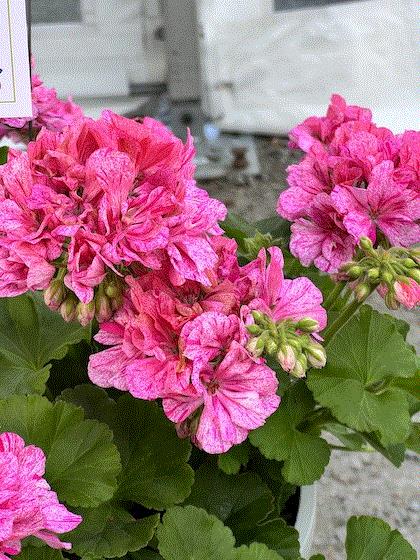
New in their ivy geranium series Great Balls of Fire are Hot Pink, Lilac and an improved White. This series was bred for high edema resistance and reliable mother stock production—benefitting the entire supply chain, from farm to grower.
Chris: A nice choice that I’d agree with. Okay, I pick their new I’conia Begonia intros. Like the geraniums, I’conia are all interspecific hybrids, giving them plenty of hybrid vigor. There’s a range of sizes and habits, and all take full sun. Additions to the collection include First Kiss Saffron (semi-double with an upright habit), Upright Blush (single flowers and, as the name implies, it’s upright), Portofino Dark Orange (mounded with double flowers and chocolate foliage), and a stand-alone called La Luna, with pinky-peach semi-double flowers and dark foliage. All are big and bold. This is Upright Blush and Portofino Dark Orange.
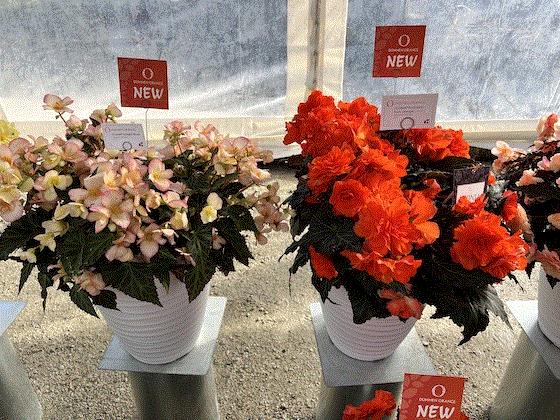
Bill: Coleus! I think there’s more excitement around coleus than any other species, thanks to new sizes and colors. New at Dümmen this year is the Down Town collection—launched with seven colors and patterns. The story on these (and why they’re named that way) is that the series is a “down”-sized version of their Main Street Coleus collection. Down Town varieties are named for cities—like Vegas Neon (pictured), Miami Magic, Columbus, Greenville … you get the idea. They’re excellent, full sun stand-alone or combo component plants, well-matched and super late to flower. Oh, and to help with sourcing efficiency, Dümmen has moved all coleus production to El Salvador.
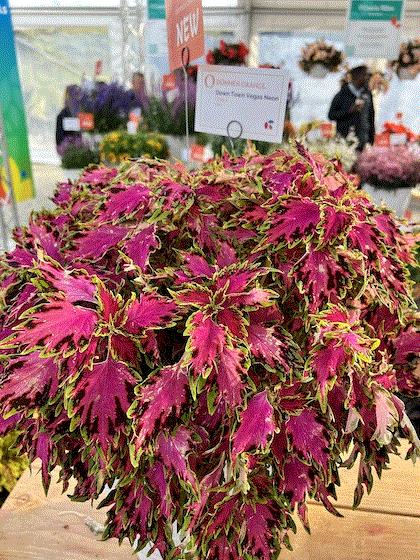
Chris: Another annual crop that sees a lot of action is dahlias—and, like coleus—there’s a range of sizes and shapes for every pot and market. Dümmen has an all-new series called Revelation, a dark-foliaged offering with semi-double flowers. It will replace their Mystic series, which they say was a bit too vigorous and uneven. Revelation starts with five colors (only four are shown here; Red is missing).
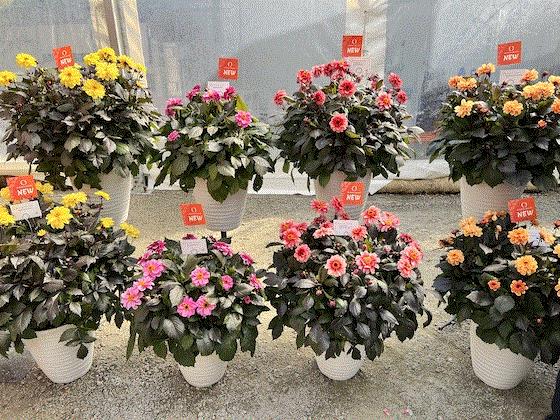

More from Dümmen ...
Bill: Besides my own two girls, I am a big fan of Jen Z’s daughter, Olivia—she’s a cool kid (for a teenager). She’s also a ballerina, currently learning pointe. So, in honor of her, I have to mention Dümmen’s new series of fuchsia named Ballerina’s. Yes, that’s correct, Ballerina’s, possessive, because the seven colors are all named for ballet poses—like Ballerina’s Pirouette, Ballerina’s Brisé, Tendu, Relevé and so on. The series is daylength neutral so early to flower with a tighter habit than most fuschias and excellent heat tolerance.
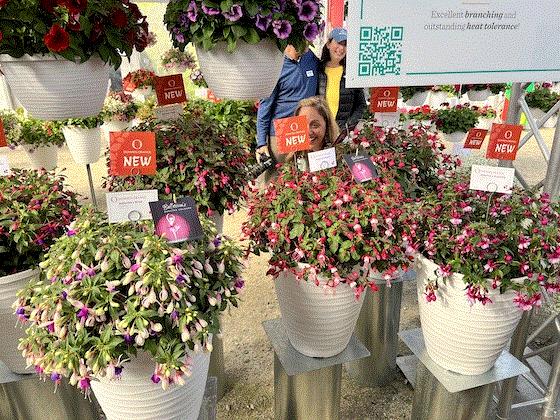
Chris: I’m going to shout-out an unusual offering: landscape kalanchoes. Calor is a big, vigorous series bred for landscape and patio use. And it was bred by the same fellow responsible for the famous Calandiva Kalanchoes! There are five colors. And speaking of Calandivas, there's a new one called Decorative Franklin … a weird name for a striking plant with flowers that range from yellow to peach to pink as they mature. They didn't have a great example to photograph, but if you grow Calandiva, give it a try!
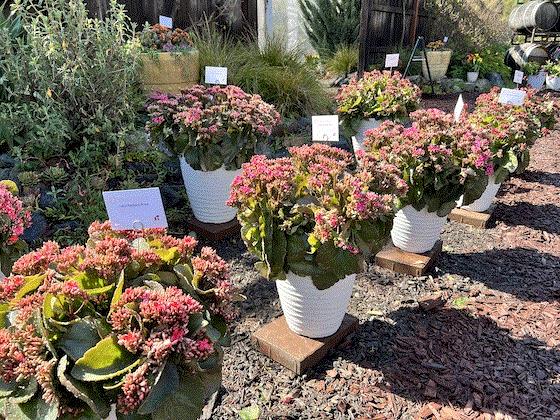
Bill: I’ve covered my favorite three annuals, so now I’ll give a shout out to the perennials I liked, starting with four new Salvia nemerosas. Dümmen’s first such series was Salute—proving that breeding is ongoing in the line, they’ve added another new color for 2024, Neon Pink.
Noble Night is the beginning of another new nemarosa series bred for huge flowers and dark stems. It’s said to flower early and fit nicely in 2.5-quart pots.
Noche (below) is a stand-alone nemarosa with an extremely dark calex and flower. The novel characteristic of Noche is that even when the blooms fade, the plant still looks nice with the dark profile. Lastly, Dümmen has a new nemarosa called Caramia Rosa that’s going to be a hit with nursery growers because three liners will fill 3- or even 5-gal. pots and grow 2.5 to 3 ft. tall in landscapes.
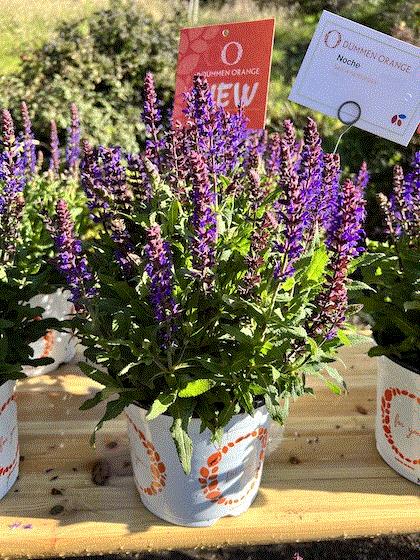
Chris: Last year, Dümmen Orange’s big intro was their Welcome to the Jungle collection of foliage and succulents to which they’ve continue to add species, including pothos, pereskia, crassula, various “strings of …”, peperomia and more. They showed those, plus loads of potting and packaging inspiration, in the dining area at Filipponi Ranch. I especially liked the big hanging basket with the twinkly lights in them. I might try that in one of my own garden destinations!
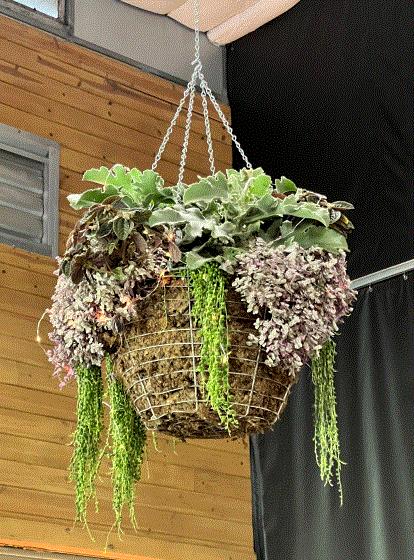
Bill: I’ll wrap up my top five from Dümmen with another perennial—iberis. Tradionally, the bright white flowers on iberis are in bloom very early in the season—before garden centers start to get busy in spring, which limits sales opportunities. Last year, they introduced White Shadow, which adds a couple of weeks to the flower time of their standard iberis, helping reduce this challenge. This year, they took moving the bloom season of iberis to a whole new level with the variety Candy Sorbet. This one, you start in December and finished for JULY sales. Yep, a summer iberis! Granted, it’s not pure white like White Shadow; instead, it’s a beautiful lilac pink. The plants on display at CAST weren’t in bloom (hey, it’s not July yet!), but I saw pics and really think this one has potential.
Chris: One last pick, eh? Hmmm … that’s tough! There’s still a lot to choose from … and I was going to leave the perennials to our expert, Paul Pilon, who was at Dümmen ahead of us, but I can’t resist mentioning Lavender LaDiva Papillon White, a Spanish lavender with clear white flags—something that’s hard to achieve on a white lavender. Of course, the vast majority of lavenders sold are not white—maybe a good crisp, clear one will help move the needle for white lavender.
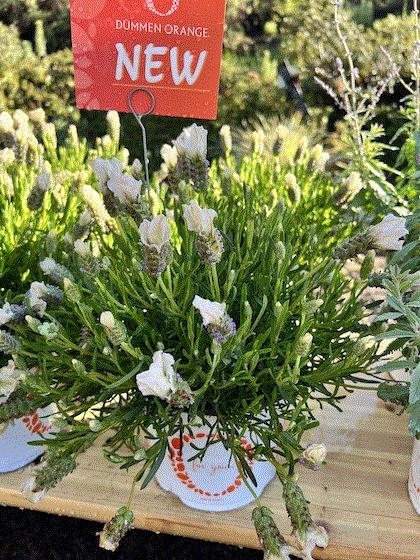
Okay, Bill, take us up Highway 101 to our next stop, Sakata.

Late Afternoon With Sakata
Bill: Sakata has long been known for pansy and violas, and it honestly brought a smile to my face to finally see some at CAST this year—our first of the season! New for 2024 was a pansy and a viola … actually a pansy/viola cross. The new pansy is Spring Grandio Lavender Shades, with a flower color that’s quite unique. Each bloom is a different shade, from light to dark lavender. The blooms don’t fade to different tones as they age; they start with that tone and it just intensifies—like a mix without having to make a mix. It’s quick to flower when grown in cooler temps and lower light environments and ready for early spring markets.

The pansy/viola cross is ColorMax, a hybrid series with hybrid vigor. It has huge flowers, but the durability of a viola. I asked if it was positioned for fall or spring and the answer was both. Blue Jeans is the new color.
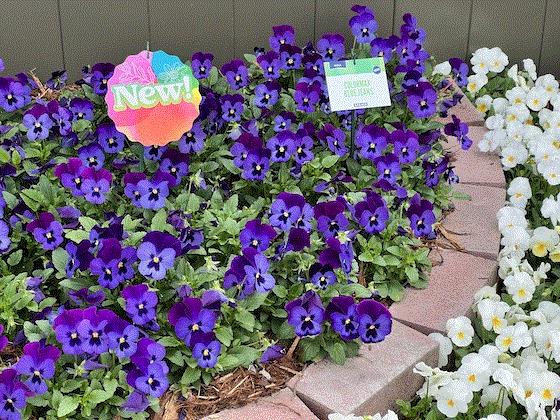
Chris: Seeing how petchoas (those petunia/calibrachoa crosses) were a topic back down the coast, it’s only fair to mention the one that started it, SuperCal. Sakata calls theirs a petunia, however, since the flowers are so big and petunia-like. It doesn’t really matter, as long as they look good and perform. New to the series is SuperCal Premium (meaning more suited to fall, although, really, you can grow any of them anytime) Red Maple, which sports a stunning red color with an orange eye. It’s a traffic-stopper and an endcap item.
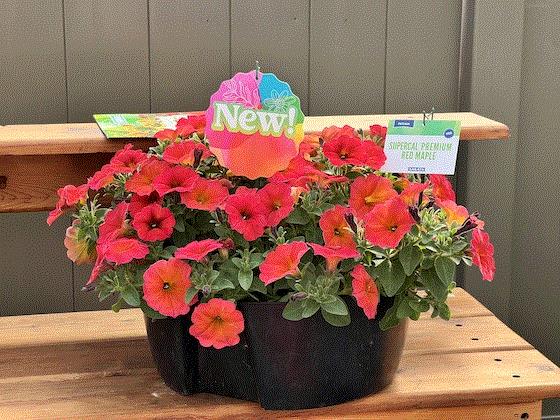
Bill: I want to give a quick shout out to the new Gerbera Majorette Orange & Yellow Bicolor Dark Eye—a long name, but a beautiful bloom. It’s a large orange flower with a strong and stable yellow ring around the dark center. Like other modern gerbera daisy breeding programs, Majorettes promise two blooms up and two buds coming. And they say Majorette is more uniform in timing between colors (10 days from first to last to bloom, vs. three weeks).
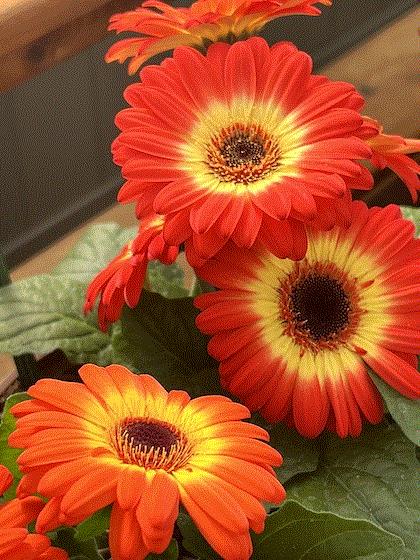
Chris: It’s a no-brainer to pick their newest SunPatiens, Compact Red Candy, as a favorite. They’re working on bringing more bicolors to the line and this is one of them.
Hey, Bill, you like peppers, especially hot ones, much more than I do. Why don’t you tackle Sakata’s new veggies?
Bill: I’m on it, boss. Let’s start hot. Shockwave Jalapeño is not only resistant to Phytophthora, but is also the hottest jalapeño in Sakata’s lineup, at 7,000 to 8,000 Scovilles.
Not hot, but promising to be tasty is Sargento (say “sar-hento”), a poblano that delivers fruit in 80 to 85 days. For cooking ease, it’s two-lobed, meaning flat on the sides, so it won’t roll off the pan or plate when you’re making chili rellenos.
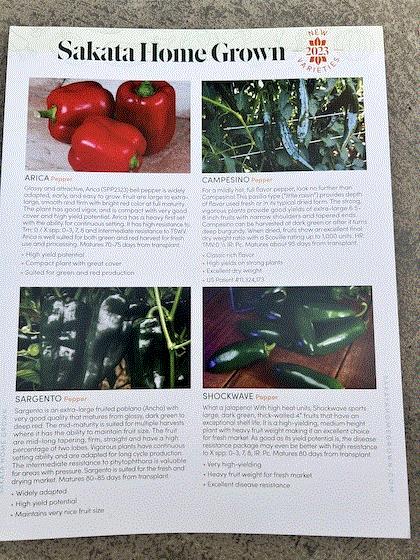
Ceres is a butternut squash that’s also earlier than others (90 to 95 days) while keeping a traditional butternut shape. As a bonus, it has good powdery mildew resistance.
Finally, a pepper that you’d like, Chris. Arica is a sweet red bell that matures in 70 to 75 days and produces lots of fruit. This isn’t one of those annoying bell peppers that produces just a couple of fruits and leaves you wanting more.

New from Kientzler
Chris: That’s a good sampling of the new offerings from Sakata. Now on to Kientzler, which was borrowing some space in one of their greenhouses. Not a big selection of offerings, but we can pick one each. I’ll start with Lobelia Blue Breeze, an interspecific lobelia bred for superior heat- and drought-tolerance. It’s a big plant, but fairly tidy and will make a statement with bright blue flowers covering all the foliage. Will it hold up as well or even better than the existing heat-tolerant lobelias on the market? We'll have to hit the summer trials to find out!
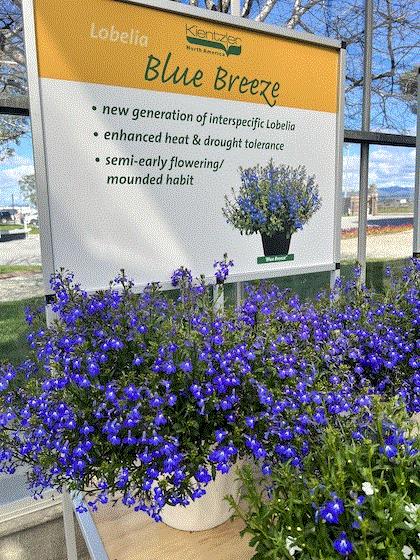
Bill: I really liked their new Begonia Bellissa, a boliviensis hybrid, with an upright habit and tons of flowers on top. They told us it can be grown in just about any size pot from 4-in. to baskets. They’ve got four colors in the series—Orange, Red, White and Yellow.
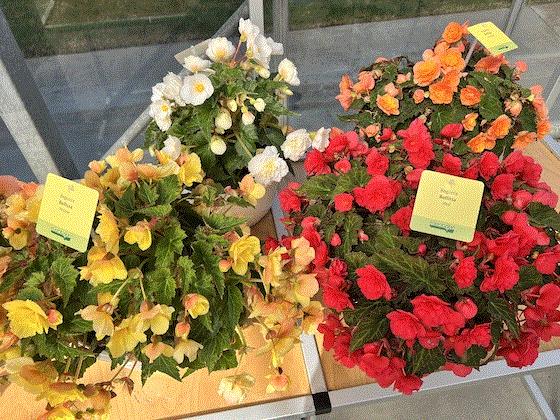
Chris: That’s a wrap on the highlights from Day 3. Of course, as we always preach, we can only write about a small fraction of what was displayed. If you want to see more, check out our videos from the trials, in which we highlight even more of the introductions:
Tomorrow, we have a busy day up in the Gilroy area, visiting American Takii, Danziger and Syngenta. Stay tuned! And be sure to click any of our names below to comment, suggest or what-have-you.
Bill: Thanks for reading and watching, everybody! For more photos and some quick live videos, follow GrowerTalks & Green Profit on Facebook and connect with us on Instagram @growertalksgreenprofit.






Thanks for reading! See you next time,
Chris, Jen, Bill & Osvaldo
Chris Beytes
Editor
GrowerTalks/Green Profit
Jen Zurko
Managing Editor
GrowerTalks/Green Profit
Bill Calkins
Senior Editor/Digital Editor
GrowerTalks/Green Profit
Osvaldo Cuevas
Video Producer
GrowerTalks/Green Profit
This email received by 31,465 lucky folks, and you're one of them!
Want to be one of the lucky sponsors who reach those 31,588 readers of Acres of Buzz from Spring Trials? Drop Paul Black a line and he'll tell you what a bargain it is!